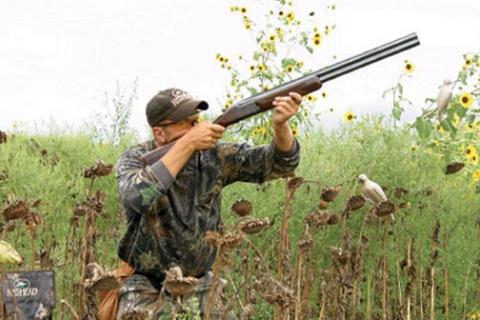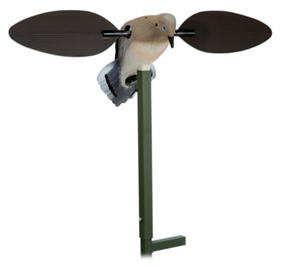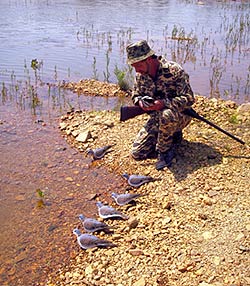
Nothing says it's time to begin hunting season like a good dove shoot. When the birds and the lead are flying, there's nothing quite like it.
Although dove hunting is one of the simplest forms of recreation available to wingshooters, getting started can seem complicated for beginners. It shouldn't be. Besides your hunting license and Migratory Bird Permit, all you really need to enjoy this great sport is a shotgun, some shotgun shells and a place to hunt. The following guide to dove hunting basics is sure to help as well.
1. Dove Hunters Must be Concealed
Doves use keen eyes from high vantage points to spot hunters. To help even the playing field, hunters must be properly concealed. Wear camo clothing matching your surroundings. Try to blend into features of the landscape — patches of standing grain missed during harvest, tree-line edges, etc. Consider fashioning a blind from corn stalks, brush or other local materials. Camo tape or finish on your shotgun helps hide gun movements. Camo grease paint or a mask hides the shine on your face.
2. Dove Decoy Placement

Several dove decoys placed near your stand can entice birds to fly by at close range. You can purchase decoys — shell, full-body and even robo-dove decoys — from sporting-goods businesses, or create silhouettes from cardboard.
Place several decoys on open ground and several on nearby fences or dead trees. Fence decoys should be about a foot apart on the top strand of wire. Tree decoys should be placed as high as possible, back from the tips of limber branches. Face all decoys into the wind; doves take off and land into the wind.
Also Read: Dove Hunting Basics: Tips on Guns, Loads and Shooting
3. Understanding Dove Habits
Understanding mourning dove habits will assist you in pinpointing game.
Know first that doves are seed-eaters. They feed on sunflowers, corn, wheat, oats, millet and other grain crops, plus many weed seeds, from foxtail to croton. They prefer eating on bare ground because their legs aren't strong enough to scratch through litter or long enough to clear many hurdles.

Doves usually fly from their night roost to a watering hole shortly after dawn, then quickly move to feeding areas where they stay until midday. They loaf at perching, watering or graveling sites near the feeding area for an hour or two around noon, then return to the feeding area for the remainder of the afternoon. Before going to roost, they usually go to water again.
Also Read: 5 Things to do Before Dove Season
4. Dove Scouting Basics
Determining the exact time and locale of these dove activities allows you to ascertain the best time and place to hunt a particular site. Do this by scouting prior to each hunt.
Begin by scanning a likely site with binoculars. Scout before 9 A.M. or after 3 P.M. when birds are more likely to be moving. When you see doves, watch for several minutes. If more doves follow, you've found a potential hunting site.
Most dove aficionados hunt fields of just-harvested grain crops. When scouting these, try to determine when doves are entering and exiting, and examine each locale for types of "structure" doves orient to when flying. A dip in perimeter timber may be a well-used travel lane. Field corners often funnel doves in and out. Open mid-field humps are preferred feeding sites because they provide a better view of approaching danger. Doves often light on snags or power lines before landing or while loafing. Points, ditches, borders between stubble and plowed ground, fence and tree lines, tall trees and other structure serve as reference points for flying doves, as well. If scouting reveals numerous doves flying near such spots, you've found a place to make your stand.
Remember, too, that feeding field hunts usually are best when enough hunters are present to keep doves stirred up and flying. Birds may move to new locales, however, if hunting pressure is heavy for more than a day or so. Observing hunting activity may thus prove useful in your search for a good shooting area.
Watering sites are another key feature of dove hot spots. Doves generally drink at muddy ponds, seeps, mud holes and stream banks with edges free of tall vegetation. Water bodies with a wide swath of open mud along shore are ideal, especially when near roosts or feeding areas.
Don't overlook graveling sites, either. Doves consume grit to help the gizzard grind seeds they eat. Rural roads, sand bars, gravel quarries and other graveling spots close to feeding, watering and roosting sites make an area more attractive to doves, and if your scouting reveals activity patterns, these areas can provide alternative hunting sites during midday when doves aren't feeding in fields.
Doves' activity patterns may change due to adverse weather conditions, changes in feeding field conditions and other factors. To have the best hunt possible, identify several potential hunting sites. Visit them often. Watch doves throughout the day to determine when and where they're flying.
Go Get 'Em!
Now that you've completed Dove Hunting 101, it's time to get in the field and start scouting. Employ the tips and tactics you've learned here, and you're sure to enjoy the exciting, fast-paced wingshooting provided by America's favorite game birds.
Read article: What Argentina Doves Taught Me About Wingshooting.
- 220700 views

